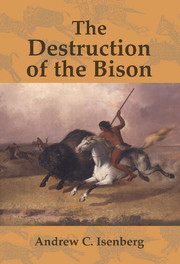3 - The Nomadic Experiment
Published online by Cambridge University Press: 05 August 2012
Summary
When the equestrian nomads rose to dominance in the Great Plains at the end of the eighteenth century, the bison was the largest mammal in North America, but it was not the largest animal ever to have inhabited the continent. Between twelve thousand and fourteen thousand years ago, during the last Ice Age, glaciers edged into the plains to the north and forests covered much of the plains to the south. In this period – the Pleistocene epoch – large herbivores now extinct such as the mammoth (mammuthus primigenius) and the giant bison (bison latifrons) foraged in mid-continental North America. As the Ice Age ended, global warming and human predation conspired to kill off the giant mammals (a lethal combination of anthropogenic and environmental pressures that foreshadowed the near-extinction of the bison thousands of years later). The extinction of the large herbivores coincided with the appearance of Paleoindian hunting societies in North America. The enormous glaciers of the Pleistocene epoch had lowered the sea level sufficiently to create a land bridge between Siberia and Alaska in what is now the Bering Strait. Paleoindians probably came from Asia to America between twenty-five thousand and twenty thousand years ago, and again between fourteen thousand and ten thousand years ago, while the Bering land bridge existed but glaciers did not block the migration.
- Type
- Chapter
- Information
- The Destruction of the BisonAn Environmental History, 1750–1920, pp. 63 - 92Publisher: Cambridge University PressPrint publication year: 2000

